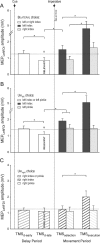Evidence for two concurrent inhibitory mechanisms during response preparation
- PMID: 20220014
- PMCID: PMC2852647
- DOI: 10.1523/JNEUROSCI.5722-09.2010
Evidence for two concurrent inhibitory mechanisms during response preparation
Abstract
Inhibitory mechanisms are critically involved in goal-directed behaviors. To gain further insight into how such mechanisms shape motor representations during response preparation, motor evoked potentials (MEPs) elicited by transcranial magnetic stimulation (TMS) and H-reflexes were recorded from left hand muscles during choice reaction time tasks. The imperative signal, which indicated the required response, was always preceded by a preparatory cue. During the postcue delay period, left MEPs were suppressed when the left hand had been cued for the forthcoming response, suggestive of a form of inhibition specifically directed at selected response representations. H-reflexes were also suppressed on these trials, indicating that the effects of this inhibition extend to spinal circuits. In addition, left MEPs were suppressed when the right hand was cued, but only when left hand movements were a possible response option before the onset of the cue. Notably, left hand H-reflexes were not modulated on these trials, consistent with a cortical locus of inhibition that lowers the activation of task-relevant, but nonselected responses. These results suggest the concurrent operation of two inhibitory mechanisms during response preparation: one decreases the activation of selected responses at the spinal level, helping to control when selected movements should be initiated by preventing their premature release; a second, upstream mechanism helps to determine what response to make during a competitive selection process.
Figures





References
-
- Aron AR. The neural basis of inhibition in cognitive control. Neuroscientist. 2007;13:214–228. - PubMed
-
- Aron AR, Robbins TW, Poldrack RA. Inhibition and the right inferior frontal cortex. Trends Cogn Sci. 2004;8:170–177. - PubMed
-
- Bastian A, Schöner G, Riehle A. Preshaping and continuous evolution of motor cortical representations during movement preparation. Eur J Neurosci. 2003;18:2047–2058. - PubMed
-
- Beurze SM, de Lange FP, Toni I, Medendorp WP. Integration of target and effector information in the human brain during reach planning. J Neurophysiol. 2007;97:188–199. - PubMed
-
- Botvinick MM, Braver TS, Barch DM, Carter CS, Cohen JD. Conflict monitoring and cognitive control. Psychol Rev. 2001;108:624–652. - PubMed
Publication types
MeSH terms
Grants and funding
LinkOut - more resources
Full Text Sources
